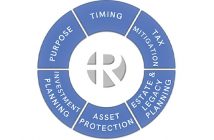A Creative Strategy for High-Income Earners to Fund a Roth IRA
Roth IRAs are a powerful way to save for retirement as it enables individuals to pay taxes upfront, so they will have a source of tax-free income in the future as all qualified withdrawals on both contributions and earnings are completely tax-free in retirement. There are other significant benefits as Roth IRAs are not subject to RMD’s (Required Minimum Distributions) after the owner turns 70 ½ and the money invested in a Roth IRA can be transferred to heirs tax-free, given that you owned it for more than five years. This makes it an attractive option for growing money tax-free and passing it along to loved ones without any tax penalties(1). In 2019, you can save up to $6,000 or $7,000 if you are 50 or older in an IRA account.
The unfortunate problem is that not all earners are created equal. To be eligible to fund a full Roth contribution in 2019, you cannot make more than $122,000 if single and $193,000 if married and filing jointly. This has an unfavorable impact on high-income individuals as they are limited when it comes to reaping the tax advantages of these accounts — under the typical rules, anyway.
I’m going to share with you a creative way for those not eligible to fund a Roth IRA to gain entry to this beneficial retirement savings vehicle in a roundabout way — and we all know how much Central Oregonians like roundabouts! This strategy is called a “backdoor” Roth and will certainly get your attention if tax-free income in retirement is important to you, yet income caps keep you from contributing to a Roth. Here’s what you need to know.
Many investors are not aware that high-income investors can still make traditional IRA contributions no matter how much income they earn and there are zero income restrictions on converting from a traditional IRA to a Roth IRA. Typically, contributions into a traditional IRA are funded with pre-tax dollars (a deduction) and all withdrawals in retirement are taxed as ordinary income, however in this example contributions would not be deductible because of their high income or they have a 401(k) or similar plan at work.
So now what? The investor makes a non-deductible IRA contribution and then immediately converts that non-deductible IRA to a Roth. It’s important to convert the traditional IRA quickly after funding it so that it generates little to no earnings as earnings will be subject to tax. Keeping the funds invested in a conservative fund in the short term could help mitigate this concern. You have just accomplished getting funds inside of a Roth IRA and all the tax and other benefits that come along with such an account. Every investor is eligible to do one Roth IRA conversion a year.
A case can be made that saving $6,000-$7,000 at a time won’t do much in terms of the future of high-income earners’ future. I would respectfully disagree, as each spouse can contribute on an annual basis and this is not only a prudent strategy for building wealth — but should only be a part of an individual’s plan. The compounding effect can have amazing results when this account is funded over multiple years, and having a portion of your income be tax-free in retirement can have positive effects on your tax diversification — something I call Diversification 2.0.
Keep in mind you can roll over and convert as much money as you want from an existing traditional IRA into a Roth IRA at one time(2). This isn’t a tax dodge, as Uncle Sam will still require you to pay taxes on the money in your traditional IRA that hasn’t been taxed. This could potentially kick you into a higher tax bracket in the year you do the conversion. However, if your income happens to be unusually low in a particular year — perhaps you took a sabbatical or had a gap in employment — you could take advantage of that situation by making the Roth conversion during this time. Timing is important and it’s also important to calculate the tax implications of a Roth IRA conversion before you make any decisions(3). The tax cost of converting a Roth is only a small price to pay if your investments continue to grow tax-free for many years inside your Roth IRA.
Investors often ask me if backdoor IRAs are permitted. My answer is “of course,” however, it remains a subject of debate, so if you want to take advantage of this strategy, you may want to do so before any policies change. Backdoor Roth IRA’s work around income caps, they can be an appealing option for certain high-wealth individuals and their financial future.
David Rosell is president of Rosell Wealth Management in Bend. He is the author of Failure is Not an Option — Creating Certainty in the Uncertainty of Retirement and Keep Climbing — A Millennial’s Guide to Financial Planning. Find David’s books on Audible and iBooks as well as Newport Market, Sintra Restaurant, Bluebird Coffee Shop, Dudley’s Bookshop, Roundabout Books, Sunriver Resort, Amazon.com and Barnes & Noble.
The information provided has been derived from sources believed to be reliable, but is not guaranteed as to accuracy. Any tax advice contained herein is of a general nature. Further, you should seek specific tax advice from your tax professional before pursuing any idea contemplated herein.
Investment advisory services offered through Valmark Advisers, Inc. an SEC Registered Investment Advisor Securities offered through Valmark Securities, Inc. Member FINRA, SIPC 130 Springside Drive, Ste 300 Akron, Ohio 44333-2431. 800-765-5201.
Rosell Wealth Management is a separate entity from Valmark Securities, Inc. and Valmark Advisers, Inc.
1-Keep in mind, however, that the heirs will experience mandatory annual withdrawals, however they can stretch them out over a lifetime, giving some room for the money to continue to compound.
2-These funds are considered converted funds, not contributions. That means you have to wait five years to have penalty-free access to your funds if you’re under 59 ½. This differs from regular Roth IRA contributions, which you can withdraw at any time without taxes or penalties.
3-Converting to a Roth isn’t without consequence. You are required to pay taxes on a portion of any funds in other traditional IRA accounts you have that aren’t converted, according to the IRS’s pro rata rule. It is suggested to work with your financial and tax advisor.




